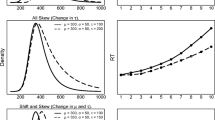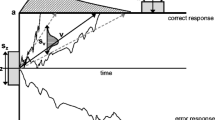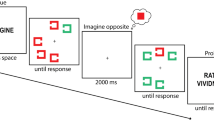Abstract
Three experiments examined reaction time (RT) performance in visual pop-out search. Search displays comprised of one color target and two distractors which were presented at 24 possible locations on a circular ellipse. Experiment 1 showed that re-presentation of the target at a previous target location led to expedited RTs, whereas presentation of the target at a distractor location led to slowed RTs (relative to target presentation at a previous empty location). RTs were also faster when the color of the target was the same across consecutive trials, relative to a change of the target’s color. This color priming was independent of the positional priming. Experiment 2 revealed larger positional facilitation, relative to Experiment 1, when position repetitions occurred more likely than chance level; analogously, Experiment 3 revealed stronger color priming effects when target color repetitions were more likely. These position and color manipulations did not change the pattern of color (Experiment 2) and positional priming effects (Experiment 3). While these results support the independency of color and positional priming effects (e.g., Maljkovic and Nakayama in Percept Psychophys 58:977–991, 1996), they also show that these (largely ‘automatic’) effects are top-down modulable when target position and color are predictable (e.g., Müller et al. in Vis Cogn 11:577–602, 2004).



Similar content being viewed by others
Notes
This alternative explanation may, in principle, also hold for the pattern of positional priming effects found in Experiments 1–3: positional priming effects may have been reduced in Experiments 1 (baseline) and 3 (predictable target color) relative to Experiment 2 (predictable target position) because, in the latter, the probability of an intervening trial (between the critical trials N − j and N) containing a same-position target was higher than the probability of a different-position target [Experiments 1 and 3: p(same-position) = 0.04, p(different position) = 0.96; Experiment 2: p(same-position) = 0.40, p(different position) = 0.60; values for Experiment 2 collapsed across trials N − 1 through N − 5]. Unfortunately, an analogous analysis to that of color priming effects (with pure sequences of same-color trials) could not be conducted for the position priming effects, because the number of pure position repetition sequences was too low in Experiments 1 and 3 to permit statistical examination. However, previous findings suggest that the relative proportions of same- and different-position trials do not affect the temporal extension of positional priming (Maljkovic and Nakayama 1996). Specifically, Maljkovic and Nakayama (1996; Experiment 2) showed that positional priming extended back 5–8 trials – importantly, independently of whether there were 6 or 12 possible target locations. That is, doubling the probability with which a given target position is repeated did not change the temporal extension of positional priming.
Of course, this does not rule out other accounts of inter-trial priming effects in terms of the retrieval of task-relevant episodic memories attributing repetition benefits at stages following focal attentional selection (i.e., stimulus-response translation; e.g., Logan, 1990, 2002; Neill, 1997; Waszak, Hommel, & Allport, 2003).
References
Braithwaite, J. J., Humphreys, G. W., Hulleman, J., & Watson, D. G. (2007). Fast color grouping and slow color inhibition: Evidence for distinct temporal windows for separate processes in preview search. Journal of Experimental Psychology: Human Perception and Performance, 33, 503–517.
Chun, M. M., & Jiang, Y. (1998). Contextual cueing: Implicit learning and memory of visual context guides spatial attention. Cognitive Psychology, 36, 28–71.
Fecteau, J. H., & Munoz, D. P. (2003). Exploring the consequences of the previous trial. Nature Reviews Neuroscience, 4, 435–443.
Geyer, T., Müller, H. J., & Krummenacher, J. (2006). Cross-trial priming in visual search for singleton conjunction targets: Role of repeated target and distractor features. Perception & Psychophysics, 68, 736–749.
Geyer, T., Müller, H. J., & Krummenacher, J. (2007). Cross-trial priming of element positions in pop-out visual search is dependent on regular stimulus arrangement. Journal of Experimental Psychology: Human Perception & Performance, 33, 788–797.
Hillstrom, A. (2000). Repetition effects in visual search. Perception & Psychophysics, 62, 800–817.
Huang, L., Holcombe, A. O., & Pashler, H. (2004). Repetition priming in visual search: Episodic retrieval, not feature priming. Memory and Cognition, 32, 12–20.
Ihaka, R., & Gentlemen, R. (1996). R: a language for data analysis and graphics. Journal of Computational and Graphical Statistics, 5, 299–314.
Klein, R. M., Munoz, D. P., Dorris, M. C., & Taylor, T. L. (2001). Inhibition of return in monkey and man. In C. Folk & B. Gibson (Eds.), Attraction, Distraction, and Action: Multiple Perspectives on Attention Capture (pp. 27–47). Amsterdam: Elsevier.
Kristjánsson, A., Wang, D., & Nakayama, K. (2002). The role of priming in conjunctive visual search. Cognition, 85, 37–52.
Kristjánsson, A., Vuilleumier, P., Malhotra, P., Husain, M., & Driver, J. (2005). Priming of Color and Position during Visual Search in Unilateral Spatial Neglect. Journal of Cognitive Neuroscience, 17, 859–873.
Kristjánsson, A., Vuilleumier, P., Schwartz, S., Macaluso, E., & Driver, J. (2007). Neural basis for priming of pop-out during visual search revealed with fMRI. Cerebral Cortex, 17, 1612–1624.
Logan, G. (1990). Repetition priming and automaticity: Common underlying mechanisms? Cognitive Psychology, 22, 1–35.
Logan, G. (2002). An instance theory of attention and memory. Psychological Review, 109, 376–400.
Maljkovic, V., & Nakayama, K. (1994). Priming of pop-out: I. Role of features. Memory & Cognition, 22, 657–672.
Maljkovic, V., & Nakayama, K. (1996). Priming of pop-out: II. The role of position. Perception & Psychophysics, 58, 977–991.
Maljkovic, V., & Nakayama, K. (2000). Priming of pop-out: III. A short-term memory system beneficial for rapid target selection. Visual Cognition, 7, 571–595.
McCarley, J. S., & He, Z. J. (2001). Sequential priming of 3-D perceptual organization. Perception & Psychophysics, 63, 195–208.
Müller, H. J., Krummenacher, J., & Heller, D. (2004). Dimension-specific inter-trial facilitation in visual search for pop-out targets: Evidence for a top-down modulable visual short-term memory effect. Visual Cognition, 11, 577–602.
Müller, H. J., Reimann, B., & Krummenacher, J. (2003). Visual search for singleton feature targets across dimensions: Stimulus- and expectancy-driven effects in dimensional weighting. Journal of Experimental Psychology: Human Perception and Performance, 29, 1021–1035.
Müller, H. J., & von Mühlenen, A. (2000). Probing distractor inhibition in visual search: Inhibition of return. Journal of Experimental Psychology: Human Perception and Performance, 26, 1591–1605.
Müller, H. J., von Mühlenen, A., & Geyer, T. (2007). Top-down inhibition of search distractors in parallel visual search. Perception and Psychophysics, 69, 1373–1388.
Neill, W. T. (1997). Episodic retrieval in negative priming and repetition priming. Journal of Experimental Psychology: Learning, Memory, and Cognition, 23, 1291–1305.
Ogawa, H., Takeda, Y., & Kumada, T. (2007). Probing attentional modulation of contextual cueing. Visual Cognition, 15, 276–289.
Segalowitz, S. J., & Graves, R. E. (1990). Suitability of the IBM XT, AT, and PS/2 keyboard, mouse, and game port as response devices in reaction time paradigms. Behavior Research Methods, Instruments and Computers, 22, 283–289.
Shore, D. I., & Klein, R. M. (2000). On the manifestations of memory in visual search. Spatial Vision, 14, 59–75.
Töllner, T., Gramann, K., Müller, H. J., Kiss, M., & Eimer, M. (2008). Electrophysiological markers of visual dimension changes and response changes. Journal of Experimental Psychology: Human Perception and Performance: 34, 531–542.
Wang, D. L., Kristjánsson, A., & Nakayama, K. (2005). Efficient visual search without top-down or bottom-up guidance. Perception & Psychophysics, 67, 239–253.
Waszak, F., Hommel, B., & Allport, A. (2003). Task switching and long-term priming: Role of episodic stimulus-task bindings in task shift costs. Cognitive Psychology, 46, 361–413.
Wolfe, J. M., Butcher, S. J., Lee, C., & Hyle, M. (2003). Changing your mind: On the contributions of top-down and bottom-up guidance in visual search for feature singletons. Journal of Experimental Psychology: Human Perception and Performance, 29, 483–502.
Author information
Authors and Affiliations
Corresponding author
Additional information
This research was supported by DFG grants FOR480 and EC142 (Excellence Cluster ‘CoTeSys’). Correspondence concerning this article should be addressed to: Thomas Geyer, Ludwig Maximilian University Munich, Department of Psychology, Leopoldstraße 13, 80802 München, Germany (email: geyer@lmu.de).
Rights and permissions
About this article
Cite this article
Geyer, T., Müller, H.J. Distinct, but top-down modulable color and positional priming mechanisms in visual pop-out search. Psychological Research 73, 167–176 (2009). https://doi.org/10.1007/s00426-008-0207-x
Received:
Accepted:
Published:
Issue Date:
DOI: https://doi.org/10.1007/s00426-008-0207-x




